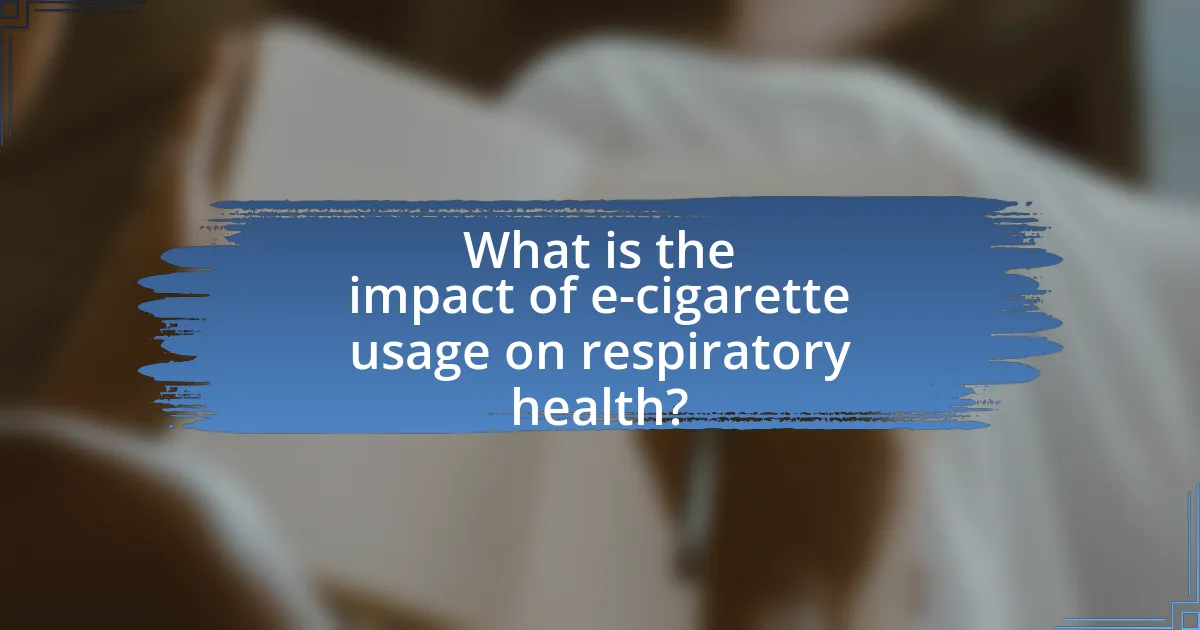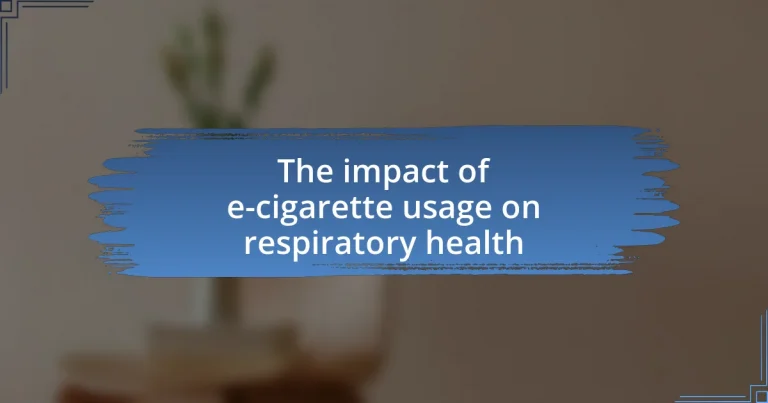E-cigarette usage has been shown to negatively impact respiratory health, leading to inflammation and impaired lung function. Research indicates that inhaling e-cigarette aerosol can result in respiratory symptoms such as cough, wheezing, and increased susceptibility to infections, with users experiencing higher rates of chronic bronchitis and asthma exacerbations compared to non-users. The presence of harmful substances in e-cigarette vapor, including formaldehyde and acrolein, contributes to airway irritation and potential long-term lung damage. Additionally, vulnerable populations, particularly adolescents and individuals with pre-existing respiratory conditions, face heightened risks associated with e-cigarette use. This article examines the short-term and long-term effects of e-cigarettes on respiratory health, the mechanisms by which they cause harm, and potential preventive measures to mitigate these impacts.

What is the impact of e-cigarette usage on respiratory health?
E-cigarette usage negatively impacts respiratory health by causing inflammation and impairing lung function. Studies have shown that inhaling e-cigarette aerosol can lead to respiratory symptoms such as cough, wheezing, and increased susceptibility to respiratory infections. Research published in the journal Tobacco Control indicates that e-cigarette users experience a higher incidence of chronic bronchitis symptoms compared to non-users. Additionally, the presence of harmful substances like formaldehyde and acrolein in e-cigarette vapor contributes to airway irritation and potential long-term lung damage.
How do e-cigarettes affect lung function?
E-cigarettes negatively affect lung function by causing inflammation and impairing respiratory health. Studies have shown that the inhalation of e-cigarette aerosol can lead to increased airway resistance and reduced lung capacity. For instance, research published in the journal “Tobacco Control” found that e-cigarette users exhibited a decline in lung function comparable to that of traditional cigarette smokers, indicating that e-cigarettes are not a safe alternative. Additionally, the presence of harmful substances in e-cigarette vapor, such as formaldehyde and acrolein, contributes to lung damage and respiratory issues.
What specific respiratory conditions are linked to e-cigarette usage?
E-cigarette usage is linked to several specific respiratory conditions, including chronic bronchitis, asthma exacerbations, and increased susceptibility to respiratory infections. Research indicates that the inhalation of e-cigarette aerosol can lead to inflammation and damage in the airways, contributing to chronic bronchitis symptoms. A study published in the journal Tobacco Control found that e-cigarette users reported higher rates of asthma attacks compared to non-users. Additionally, e-cigarettes can impair immune responses in the lungs, making individuals more vulnerable to infections such as pneumonia.
How does e-cigarette vapor compare to traditional cigarette smoke in terms of respiratory effects?
E-cigarette vapor generally has fewer harmful respiratory effects compared to traditional cigarette smoke. Traditional cigarette smoke contains thousands of toxic chemicals, including tar and carbon monoxide, which significantly impair lung function and contribute to respiratory diseases such as chronic obstructive pulmonary disease (COPD) and lung cancer. In contrast, e-cigarette vapor primarily consists of nicotine, propylene glycol, and vegetable glycerin, with fewer harmful substances. Research published in the journal “Tobacco Control” indicates that while e-cigarette vapor can still irritate the airways, it does not produce the same level of harmful byproducts as combustion from traditional cigarettes. This suggests that e-cigarettes may pose a lower risk for respiratory health, although long-term effects are still being studied.
What are the short-term effects of e-cigarette usage on respiratory health?
Short-term effects of e-cigarette usage on respiratory health include increased airway resistance, coughing, and wheezing. Research indicates that inhaling e-cigarette aerosol can lead to inflammation of the airways and reduced lung function, as evidenced by a study published in the journal Tobacco Control, which found that e-cigarette users experienced significant respiratory symptoms compared to non-users. Additionally, exposure to e-cigarette vapor has been shown to impair mucociliary function, which is crucial for clearing mucus and pathogens from the respiratory tract.
How does e-cigarette usage influence symptoms like coughing and wheezing?
E-cigarette usage significantly increases the incidence of symptoms like coughing and wheezing. Research indicates that inhaling e-cigarette aerosol can irritate the airways, leading to inflammation and increased mucus production, which are known contributors to these respiratory symptoms. A study published in the journal Tobacco Control found that e-cigarette users reported higher rates of coughing and wheezing compared to non-users, highlighting the negative impact of e-cigarettes on respiratory health.
What immediate changes occur in lung capacity after e-cigarette use?
Immediate changes in lung capacity after e-cigarette use typically include a temporary decrease in lung function, characterized by reduced forced expiratory volume (FEV1) and forced vital capacity (FVC). Research indicates that inhaling e-cigarette vapor can lead to airway inflammation and bronchoconstriction, which contribute to this decline in lung capacity. A study published in the journal Tobacco Control found that e-cigarette users experienced significant reductions in lung function shortly after use, highlighting the immediate adverse effects on respiratory health.
What are the long-term consequences of e-cigarette usage on respiratory health?
Long-term e-cigarette usage can lead to significant respiratory health issues, including chronic bronchitis, reduced lung function, and increased susceptibility to respiratory infections. Studies indicate that e-cigarette aerosol contains harmful substances such as nicotine, formaldehyde, and acrolein, which can cause inflammation and damage to lung tissue. Research published in the journal Tobacco Control found that e-cigarette users exhibited a higher prevalence of respiratory symptoms compared to non-users, highlighting the detrimental effects on respiratory health over time.
How does prolonged e-cigarette use contribute to chronic respiratory diseases?
Prolonged e-cigarette use contributes to chronic respiratory diseases by introducing harmful substances into the lungs, leading to inflammation and damage to respiratory tissues. Research indicates that e-cigarette aerosol contains toxic chemicals, including formaldehyde and acrolein, which can impair lung function and promote conditions such as chronic bronchitis and asthma. A study published in the journal Tobacco Control found that long-term e-cigarette users exhibited increased respiratory symptoms and reduced lung function compared to non-users, highlighting the direct correlation between e-cigarette use and respiratory health deterioration.
What evidence exists regarding the development of asthma or COPD from e-cigarette usage?
Evidence suggests that e-cigarette usage is associated with an increased risk of developing asthma and chronic obstructive pulmonary disease (COPD). A study published in the journal Tobacco Control found that adolescents who used e-cigarettes were more likely to report asthma symptoms compared to non-users, indicating a potential link between e-cigarette use and respiratory issues. Additionally, research in the American Journal of Respiratory and Critical Care Medicine highlighted that e-cigarette aerosol contains harmful substances that can irritate the airways, potentially leading to the development of COPD over time. These findings underscore the concern that e-cigarette usage may contribute to respiratory health problems, including asthma and COPD.
How does e-cigarette usage impact vulnerable populations?
E-cigarette usage negatively impacts vulnerable populations, particularly youth, individuals with pre-existing health conditions, and low-income communities. Research indicates that adolescents are more susceptible to nicotine addiction, which can lead to long-term respiratory issues, as evidenced by a study published in the journal Tobacco Control, showing that e-cigarette use among teens is associated with increased respiratory symptoms. Additionally, individuals with asthma or chronic obstructive pulmonary disease (COPD) may experience exacerbated symptoms due to the inhalation of harmful substances found in e-cigarettes, as highlighted in a report by the American Lung Association. Furthermore, low-income communities often lack access to healthcare resources, making it difficult for them to manage the health consequences associated with e-cigarette use, thereby increasing their vulnerability to respiratory diseases.
What effects do e-cigarettes have on adolescents’ respiratory health?
E-cigarettes negatively affect adolescents’ respiratory health by causing inflammation and impairing lung function. Research indicates that the inhalation of e-cigarette aerosol can lead to increased airway resistance and reduced lung capacity, which are critical for healthy respiratory function. A study published in the journal Tobacco Control found that adolescents who use e-cigarettes are more likely to experience respiratory symptoms such as coughing and wheezing compared to non-users. Additionally, the presence of harmful chemicals in e-cigarette vapor, such as formaldehyde and acrolein, contributes to respiratory irritation and potential long-term damage to lung tissue.
How does e-cigarette usage affect individuals with pre-existing respiratory conditions?
E-cigarette usage negatively affects individuals with pre-existing respiratory conditions by exacerbating symptoms and increasing the risk of complications. Research indicates that the inhalation of e-cigarette aerosol can lead to inflammation and irritation of the airways, which is particularly harmful for those with conditions such as asthma or chronic obstructive pulmonary disease (COPD). A study published in the journal “Tobacco Control” found that e-cigarette users with asthma reported more frequent respiratory symptoms compared to non-users, highlighting the detrimental impact on lung function and overall respiratory health.
What are the mechanisms by which e-cigarettes affect respiratory health?
E-cigarettes affect respiratory health primarily through the inhalation of aerosolized substances that can cause inflammation and oxidative stress in lung tissues. The aerosol produced by e-cigarettes contains nicotine, flavoring agents, and other harmful chemicals, which can lead to airway irritation and impaired lung function. Studies have shown that exposure to e-cigarette vapor can result in increased levels of inflammatory markers in the lungs, contributing to respiratory diseases such as asthma and chronic obstructive pulmonary disease (COPD). Additionally, the presence of ultrafine particles in e-cigarette aerosol can penetrate deep into the lungs, exacerbating respiratory issues and potentially leading to long-term health consequences.
How do the chemicals in e-cigarette vapor impact lung tissue?
The chemicals in e-cigarette vapor can cause inflammation and damage to lung tissue. Studies have shown that components such as nicotine, formaldehyde, and acrolein can lead to oxidative stress and cellular injury in lung cells. For instance, research published in the journal “Tobacco Control” indicates that exposure to e-cigarette vapor can impair lung function and promote respiratory diseases by triggering inflammatory responses and altering the normal repair processes of lung tissue.
What role do flavoring agents in e-cigarettes play in respiratory health?
Flavoring agents in e-cigarettes can negatively impact respiratory health by causing inflammation and irritation in the airways. Studies have shown that certain flavoring compounds, such as diacetyl, are linked to respiratory diseases like “popcorn lung,” which is characterized by scarring of the lungs and reduced lung function. Additionally, research indicates that inhaling flavored e-cigarette aerosols can lead to increased oxidative stress and impaired lung function, further exacerbating respiratory issues.
What preventive measures can be taken to mitigate the impact of e-cigarette usage on respiratory health?
Preventive measures to mitigate the impact of e-cigarette usage on respiratory health include implementing strict regulations on e-cigarette marketing and sales, promoting public awareness campaigns about the risks associated with e-cigarette use, and encouraging cessation programs for users. Research indicates that comprehensive tobacco control policies, including age restrictions and flavor bans, can significantly reduce e-cigarette use among youth, thereby lowering the risk of respiratory issues linked to vaping. Additionally, studies show that educational initiatives can effectively inform the public about the potential harms of e-cigarettes, leading to decreased usage and improved respiratory health outcomes.
What strategies can individuals adopt to reduce respiratory risks associated with e-cigarettes?
Individuals can reduce respiratory risks associated with e-cigarettes by opting for lower nicotine concentrations and avoiding flavored e-liquids. Research indicates that high nicotine levels and certain flavoring agents can exacerbate respiratory issues, as they may contain harmful chemicals that irritate the lungs. Additionally, individuals should limit the frequency of use and avoid deep inhalation, which can further minimize exposure to harmful substances. A study published in the journal Tobacco Control found that reducing the frequency of e-cigarette use significantly lowers the risk of respiratory symptoms.
How can public health policies address the respiratory health impacts of e-cigarette usage?
Public health policies can address the respiratory health impacts of e-cigarette usage by implementing regulations that limit access to these products, particularly among youth, and by promoting public awareness campaigns about their health risks. For instance, studies indicate that e-cigarette use is associated with increased respiratory symptoms and decreased lung function, particularly in adolescents (Bhatta et al., 2020, Tobacco Control). Policies that restrict marketing to minors and establish age limits can reduce initiation rates among young people. Additionally, funding for research on e-cigarette health effects and integrating findings into educational programs can inform the public about the potential respiratory risks, thereby encouraging cessation and reducing usage rates.


